Contract Law: Analysis of InXs Ltd and Country Pine Ltd Scenario
VerifiedAdded on 2020/01/15
|18
|4983
|105
Report
AI Summary
This report provides a comprehensive analysis of contract law principles, focusing on a case study involving InXs Ltd and Country Pine Ltd. The report delves into the essential elements of contract formation, different types of contracts, and the applicability of contractual terms. It examines the validity of an exclusion clause and explores the concept of vicarious liability in relation to negligence. The report also addresses the differences between contract and negligence obligations, advising on claims for personal injuries and potential defenses. The analysis includes detailed explanations of express and implied terms, conditions, warranties, and the application of legal precedents. The conclusion summarizes the key findings, offering advice on whether the contract should prevail. The report also offers a concise overview of different types of contracts and their legal implications.
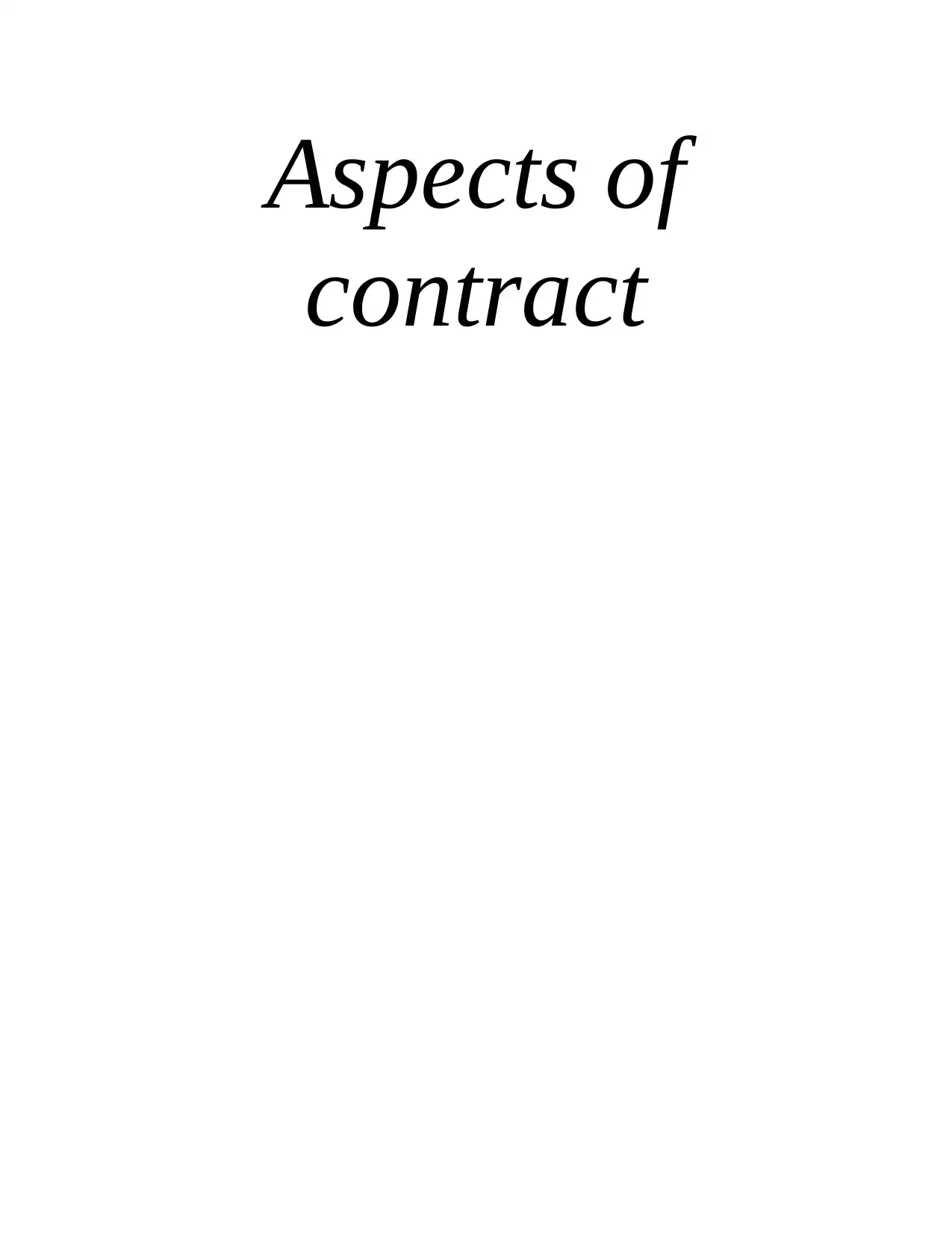
Aspects of
contract
contract
Paraphrase This Document
Need a fresh take? Get an instant paraphrase of this document with our AI Paraphraser

TABLE OF CONTENTS
Table of Contents.............................................................................................................................2
Introduction......................................................................................................................................3
Scenario 1.........................................................................................................................................3
1. Explain the essential elements that are required for the formation of contract.......................3
2. Description of different types of contract and the type of contract between InXs Ltd and
Country Pine Ltd..........................................................................................................................4
3. Advise to InXs as to whether the contract should prevail or not.............................................5
4. Applicability of contractual terms in the given case of InXs Ltd............................................6
5. Validity of exclusion clause inserted by CP in the contractual deed.......................................7
Scenario 2.........................................................................................................................................8
1. Difference between contract and negligence obligations........................................................8
2. Elements that required to be presented by claimant in order to succeed in an action for
negligence....................................................................................................................................9
3. Advice to Fiona regarding her claim of personal injuries.......................................................9
4. Defenses for country pine......................................................................................................10
5. Doctrine of vicarious liability................................................................................................10
On the basis of doctrine of vicarious liability it can be said that third party can be held liable to
provide for the damages of the negligent party. Hence on the basis of above doctrine, the
business has been aid to be vicariously liable in case of relation that exist between Master
servant/ Principal agent/ Business partner (Sweet and Schneier, 2012). In this situation all the
rules and regulations which are provided or made by the firm should be kept into
consideration and should be followed by all the employees. If employees do not follow the
guidelines provided by the organization, then ultimately firm liable towards the consequences
(Macquaet, 2012).......................................................................................................................10
6. Advice to CP regarding damages caused by Jason................................................................10
Conclusion.....................................................................................................................................11
References......................................................................................................................................12
2
Table of Contents.............................................................................................................................2
Introduction......................................................................................................................................3
Scenario 1.........................................................................................................................................3
1. Explain the essential elements that are required for the formation of contract.......................3
2. Description of different types of contract and the type of contract between InXs Ltd and
Country Pine Ltd..........................................................................................................................4
3. Advise to InXs as to whether the contract should prevail or not.............................................5
4. Applicability of contractual terms in the given case of InXs Ltd............................................6
5. Validity of exclusion clause inserted by CP in the contractual deed.......................................7
Scenario 2.........................................................................................................................................8
1. Difference between contract and negligence obligations........................................................8
2. Elements that required to be presented by claimant in order to succeed in an action for
negligence....................................................................................................................................9
3. Advice to Fiona regarding her claim of personal injuries.......................................................9
4. Defenses for country pine......................................................................................................10
5. Doctrine of vicarious liability................................................................................................10
On the basis of doctrine of vicarious liability it can be said that third party can be held liable to
provide for the damages of the negligent party. Hence on the basis of above doctrine, the
business has been aid to be vicariously liable in case of relation that exist between Master
servant/ Principal agent/ Business partner (Sweet and Schneier, 2012). In this situation all the
rules and regulations which are provided or made by the firm should be kept into
consideration and should be followed by all the employees. If employees do not follow the
guidelines provided by the organization, then ultimately firm liable towards the consequences
(Macquaet, 2012).......................................................................................................................10
6. Advice to CP regarding damages caused by Jason................................................................10
Conclusion.....................................................................................................................................11
References......................................................................................................................................12
2

3
⊘ This is a preview!⊘
Do you want full access?
Subscribe today to unlock all pages.

Trusted by 1+ million students worldwide

4
Paraphrase This Document
Need a fresh take? Get an instant paraphrase of this document with our AI Paraphraser

5

6
⊘ This is a preview!⊘
Do you want full access?
Subscribe today to unlock all pages.

Trusted by 1+ million students worldwide
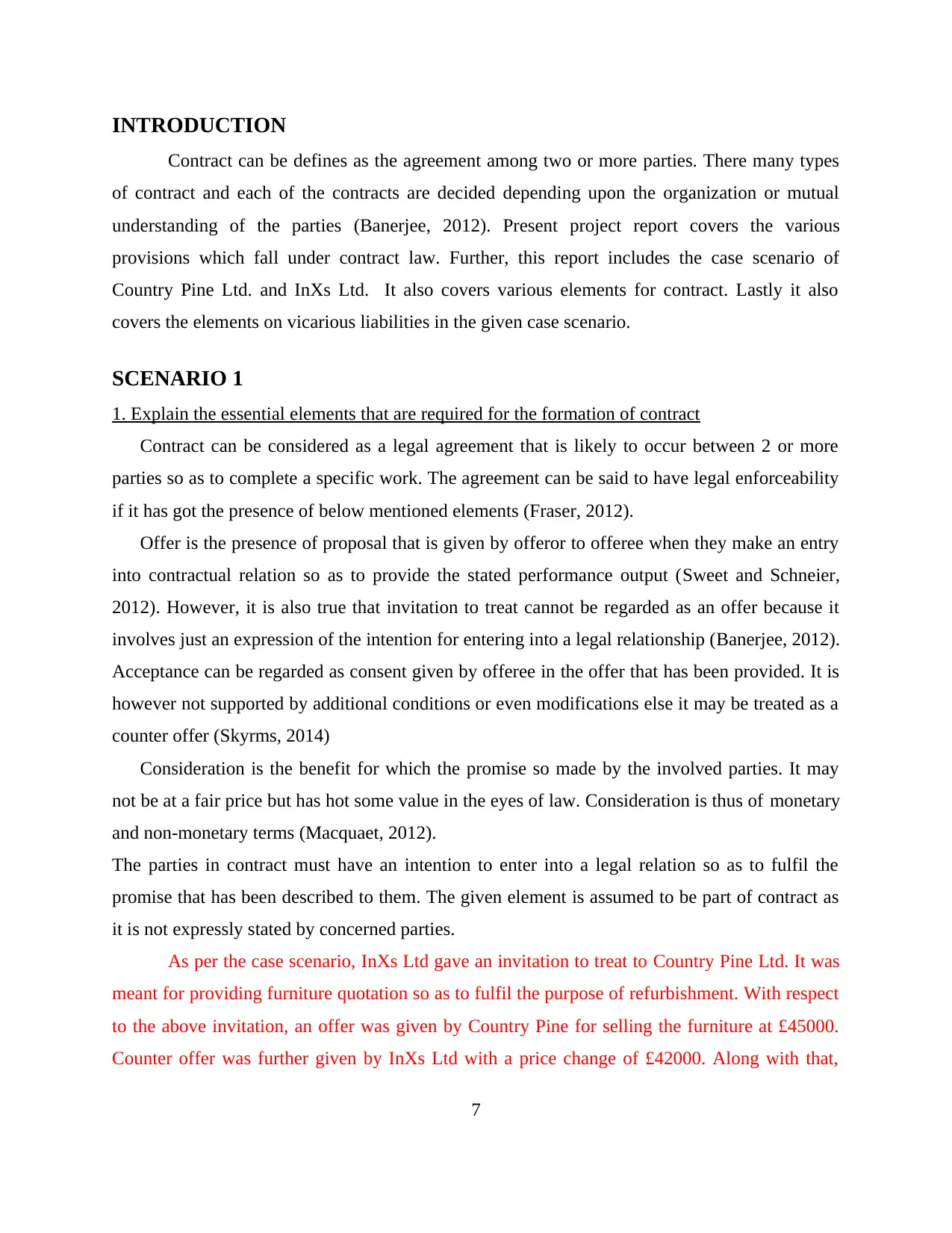
INTRODUCTION
Contract can be defines as the agreement among two or more parties. There many types
of contract and each of the contracts are decided depending upon the organization or mutual
understanding of the parties (Banerjee, 2012). Present project report covers the various
provisions which fall under contract law. Further, this report includes the case scenario of
Country Pine Ltd. and InXs Ltd. It also covers various elements for contract. Lastly it also
covers the elements on vicarious liabilities in the given case scenario.
SCENARIO 1
1. Explain the essential elements that are required for the formation of contract
Contract can be considered as a legal agreement that is likely to occur between 2 or more
parties so as to complete a specific work. The agreement can be said to have legal enforceability
if it has got the presence of below mentioned elements (Fraser, 2012).
Offer is the presence of proposal that is given by offeror to offeree when they make an entry
into contractual relation so as to provide the stated performance output (Sweet and Schneier,
2012). However, it is also true that invitation to treat cannot be regarded as an offer because it
involves just an expression of the intention for entering into a legal relationship (Banerjee, 2012).
Acceptance can be regarded as consent given by offeree in the offer that has been provided. It is
however not supported by additional conditions or even modifications else it may be treated as a
counter offer (Skyrms, 2014)
Consideration is the benefit for which the promise so made by the involved parties. It may
not be at a fair price but has hot some value in the eyes of law. Consideration is thus of monetary
and non-monetary terms (Macquaet, 2012).
The parties in contract must have an intention to enter into a legal relation so as to fulfil the
promise that has been described to them. The given element is assumed to be part of contract as
it is not expressly stated by concerned parties.
As per the case scenario, InXs Ltd gave an invitation to treat to Country Pine Ltd. It was
meant for providing furniture quotation so as to fulfil the purpose of refurbishment. With respect
to the above invitation, an offer was given by Country Pine for selling the furniture at £45000.
Counter offer was further given by InXs Ltd with a price change of £42000. Along with that,
7
Contract can be defines as the agreement among two or more parties. There many types
of contract and each of the contracts are decided depending upon the organization or mutual
understanding of the parties (Banerjee, 2012). Present project report covers the various
provisions which fall under contract law. Further, this report includes the case scenario of
Country Pine Ltd. and InXs Ltd. It also covers various elements for contract. Lastly it also
covers the elements on vicarious liabilities in the given case scenario.
SCENARIO 1
1. Explain the essential elements that are required for the formation of contract
Contract can be considered as a legal agreement that is likely to occur between 2 or more
parties so as to complete a specific work. The agreement can be said to have legal enforceability
if it has got the presence of below mentioned elements (Fraser, 2012).
Offer is the presence of proposal that is given by offeror to offeree when they make an entry
into contractual relation so as to provide the stated performance output (Sweet and Schneier,
2012). However, it is also true that invitation to treat cannot be regarded as an offer because it
involves just an expression of the intention for entering into a legal relationship (Banerjee, 2012).
Acceptance can be regarded as consent given by offeree in the offer that has been provided. It is
however not supported by additional conditions or even modifications else it may be treated as a
counter offer (Skyrms, 2014)
Consideration is the benefit for which the promise so made by the involved parties. It may
not be at a fair price but has hot some value in the eyes of law. Consideration is thus of monetary
and non-monetary terms (Macquaet, 2012).
The parties in contract must have an intention to enter into a legal relation so as to fulfil the
promise that has been described to them. The given element is assumed to be part of contract as
it is not expressly stated by concerned parties.
As per the case scenario, InXs Ltd gave an invitation to treat to Country Pine Ltd. It was
meant for providing furniture quotation so as to fulfil the purpose of refurbishment. With respect
to the above invitation, an offer was given by Country Pine for selling the furniture at £45000.
Counter offer was further given by InXs Ltd with a price change of £42000. Along with that,
7
Paraphrase This Document
Need a fresh take? Get an instant paraphrase of this document with our AI Paraphraser
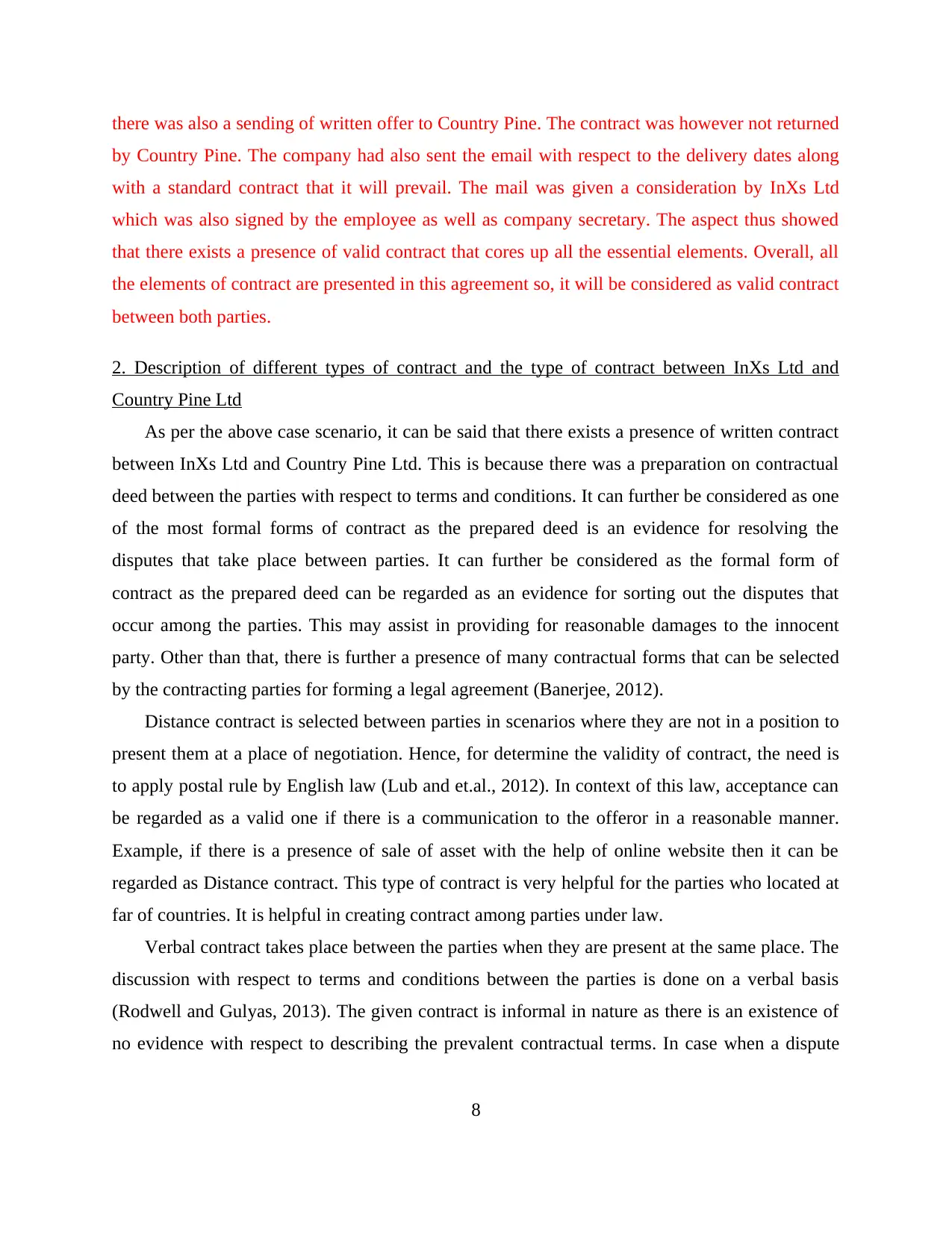
there was also a sending of written offer to Country Pine. The contract was however not returned
by Country Pine. The company had also sent the email with respect to the delivery dates along
with a standard contract that it will prevail. The mail was given a consideration by InXs Ltd
which was also signed by the employee as well as company secretary. The aspect thus showed
that there exists a presence of valid contract that cores up all the essential elements. Overall, all
the elements of contract are presented in this agreement so, it will be considered as valid contract
between both parties.
2. Description of different types of contract and the type of contract between InXs Ltd and
Country Pine Ltd
As per the above case scenario, it can be said that there exists a presence of written contract
between InXs Ltd and Country Pine Ltd. This is because there was a preparation on contractual
deed between the parties with respect to terms and conditions. It can further be considered as one
of the most formal forms of contract as the prepared deed is an evidence for resolving the
disputes that take place between parties. It can further be considered as the formal form of
contract as the prepared deed can be regarded as an evidence for sorting out the disputes that
occur among the parties. This may assist in providing for reasonable damages to the innocent
party. Other than that, there is further a presence of many contractual forms that can be selected
by the contracting parties for forming a legal agreement (Banerjee, 2012).
Distance contract is selected between parties in scenarios where they are not in a position to
present them at a place of negotiation. Hence, for determine the validity of contract, the need is
to apply postal rule by English law (Lub and et.al., 2012). In context of this law, acceptance can
be regarded as a valid one if there is a communication to the offeror in a reasonable manner.
Example, if there is a presence of sale of asset with the help of online website then it can be
regarded as Distance contract. This type of contract is very helpful for the parties who located at
far of countries. It is helpful in creating contract among parties under law.
Verbal contract takes place between the parties when they are present at the same place. The
discussion with respect to terms and conditions between the parties is done on a verbal basis
(Rodwell and Gulyas, 2013). The given contract is informal in nature as there is an existence of
no evidence with respect to describing the prevalent contractual terms. In case when a dispute
8
by Country Pine. The company had also sent the email with respect to the delivery dates along
with a standard contract that it will prevail. The mail was given a consideration by InXs Ltd
which was also signed by the employee as well as company secretary. The aspect thus showed
that there exists a presence of valid contract that cores up all the essential elements. Overall, all
the elements of contract are presented in this agreement so, it will be considered as valid contract
between both parties.
2. Description of different types of contract and the type of contract between InXs Ltd and
Country Pine Ltd
As per the above case scenario, it can be said that there exists a presence of written contract
between InXs Ltd and Country Pine Ltd. This is because there was a preparation on contractual
deed between the parties with respect to terms and conditions. It can further be considered as one
of the most formal forms of contract as the prepared deed is an evidence for resolving the
disputes that take place between parties. It can further be considered as the formal form of
contract as the prepared deed can be regarded as an evidence for sorting out the disputes that
occur among the parties. This may assist in providing for reasonable damages to the innocent
party. Other than that, there is further a presence of many contractual forms that can be selected
by the contracting parties for forming a legal agreement (Banerjee, 2012).
Distance contract is selected between parties in scenarios where they are not in a position to
present them at a place of negotiation. Hence, for determine the validity of contract, the need is
to apply postal rule by English law (Lub and et.al., 2012). In context of this law, acceptance can
be regarded as a valid one if there is a communication to the offeror in a reasonable manner.
Example, if there is a presence of sale of asset with the help of online website then it can be
regarded as Distance contract. This type of contract is very helpful for the parties who located at
far of countries. It is helpful in creating contract among parties under law.
Verbal contract takes place between the parties when they are present at the same place. The
discussion with respect to terms and conditions between the parties is done on a verbal basis
(Rodwell and Gulyas, 2013). The given contract is informal in nature as there is an existence of
no evidence with respect to describing the prevalent contractual terms. In case when a dispute
8
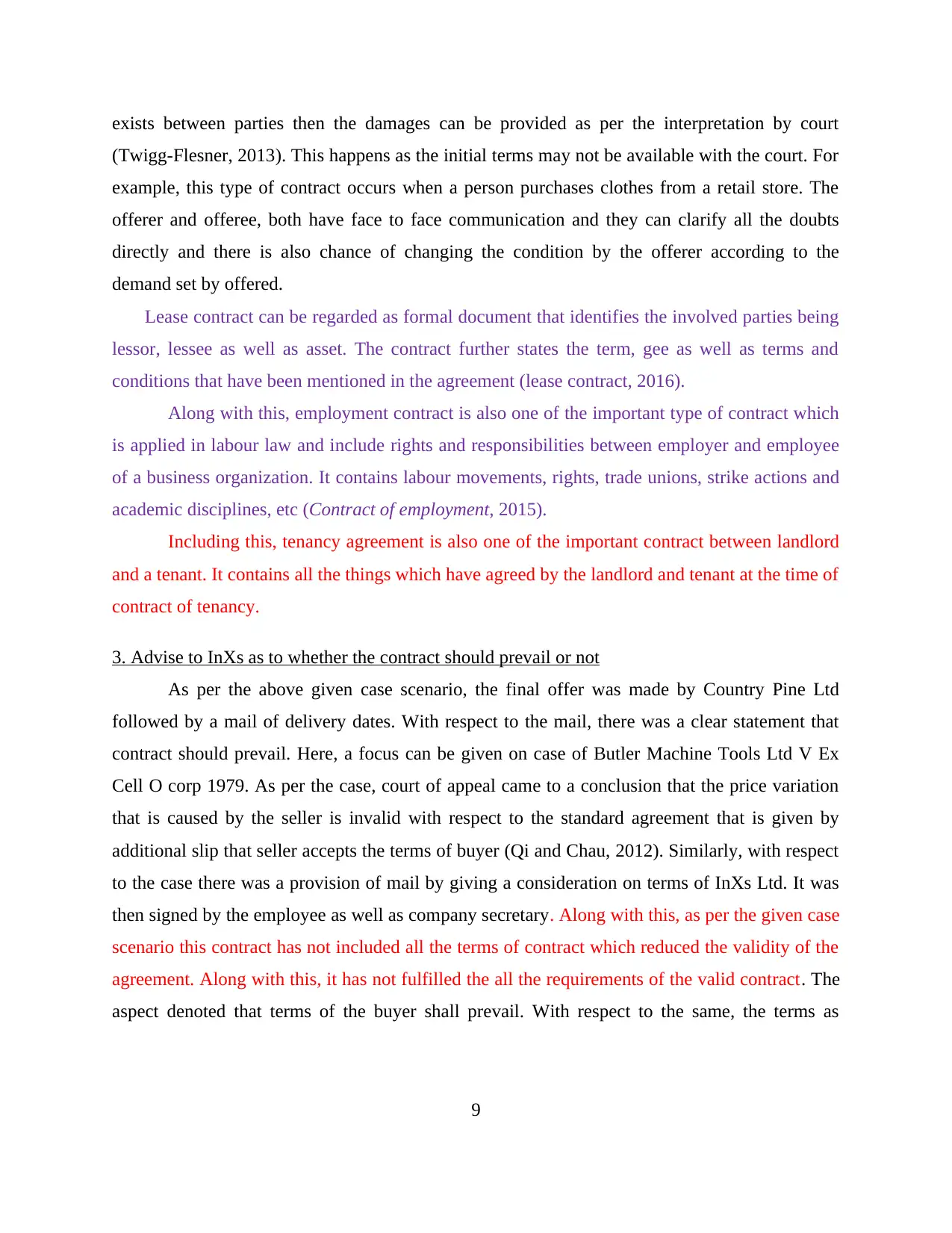
exists between parties then the damages can be provided as per the interpretation by court
(Twigg-Flesner, 2013). This happens as the initial terms may not be available with the court. For
example, this type of contract occurs when a person purchases clothes from a retail store. The
offerer and offeree, both have face to face communication and they can clarify all the doubts
directly and there is also chance of changing the condition by the offerer according to the
demand set by offered.
Lease contract can be regarded as formal document that identifies the involved parties being
lessor, lessee as well as asset. The contract further states the term, gee as well as terms and
conditions that have been mentioned in the agreement (lease contract, 2016).
Along with this, employment contract is also one of the important type of contract which
is applied in labour law and include rights and responsibilities between employer and employee
of a business organization. It contains labour movements, rights, trade unions, strike actions and
academic disciplines, etc (Contract of employment, 2015).
Including this, tenancy agreement is also one of the important contract between landlord
and a tenant. It contains all the things which have agreed by the landlord and tenant at the time of
contract of tenancy.
3. Advise to InXs as to whether the contract should prevail or not
As per the above given case scenario, the final offer was made by Country Pine Ltd
followed by a mail of delivery dates. With respect to the mail, there was a clear statement that
contract should prevail. Here, a focus can be given on case of Butler Machine Tools Ltd V Ex
Cell O corp 1979. As per the case, court of appeal came to a conclusion that the price variation
that is caused by the seller is invalid with respect to the standard agreement that is given by
additional slip that seller accepts the terms of buyer (Qi and Chau, 2012). Similarly, with respect
to the case there was a provision of mail by giving a consideration on terms of InXs Ltd. It was
then signed by the employee as well as company secretary. Along with this, as per the given case
scenario this contract has not included all the terms of contract which reduced the validity of the
agreement. Along with this, it has not fulfilled the all the requirements of the valid contract. The
aspect denoted that terms of the buyer shall prevail. With respect to the same, the terms as
9
(Twigg-Flesner, 2013). This happens as the initial terms may not be available with the court. For
example, this type of contract occurs when a person purchases clothes from a retail store. The
offerer and offeree, both have face to face communication and they can clarify all the doubts
directly and there is also chance of changing the condition by the offerer according to the
demand set by offered.
Lease contract can be regarded as formal document that identifies the involved parties being
lessor, lessee as well as asset. The contract further states the term, gee as well as terms and
conditions that have been mentioned in the agreement (lease contract, 2016).
Along with this, employment contract is also one of the important type of contract which
is applied in labour law and include rights and responsibilities between employer and employee
of a business organization. It contains labour movements, rights, trade unions, strike actions and
academic disciplines, etc (Contract of employment, 2015).
Including this, tenancy agreement is also one of the important contract between landlord
and a tenant. It contains all the things which have agreed by the landlord and tenant at the time of
contract of tenancy.
3. Advise to InXs as to whether the contract should prevail or not
As per the above given case scenario, the final offer was made by Country Pine Ltd
followed by a mail of delivery dates. With respect to the mail, there was a clear statement that
contract should prevail. Here, a focus can be given on case of Butler Machine Tools Ltd V Ex
Cell O corp 1979. As per the case, court of appeal came to a conclusion that the price variation
that is caused by the seller is invalid with respect to the standard agreement that is given by
additional slip that seller accepts the terms of buyer (Qi and Chau, 2012). Similarly, with respect
to the case there was a provision of mail by giving a consideration on terms of InXs Ltd. It was
then signed by the employee as well as company secretary. Along with this, as per the given case
scenario this contract has not included all the terms of contract which reduced the validity of the
agreement. Along with this, it has not fulfilled the all the requirements of the valid contract. The
aspect denoted that terms of the buyer shall prevail. With respect to the same, the terms as
9
⊘ This is a preview!⊘
Do you want full access?
Subscribe today to unlock all pages.

Trusted by 1+ million students worldwide
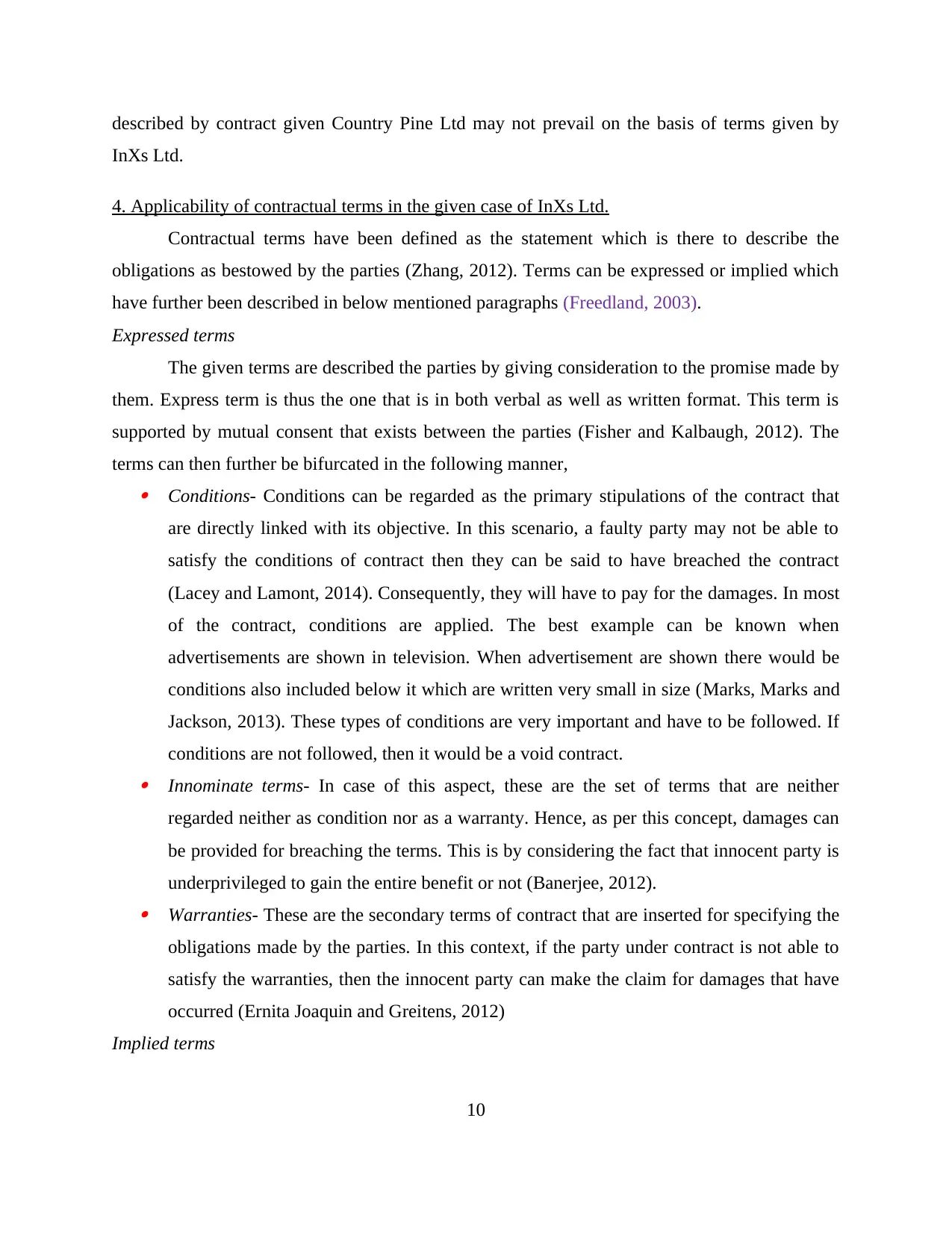
described by contract given Country Pine Ltd may not prevail on the basis of terms given by
InXs Ltd.
4. Applicability of contractual terms in the given case of InXs Ltd.
Contractual terms have been defined as the statement which is there to describe the
obligations as bestowed by the parties (Zhang, 2012). Terms can be expressed or implied which
have further been described in below mentioned paragraphs (Freedland, 2003).
Expressed terms
The given terms are described the parties by giving consideration to the promise made by
them. Express term is thus the one that is in both verbal as well as written format. This term is
supported by mutual consent that exists between the parties (Fisher and Kalbaugh, 2012). The
terms can then further be bifurcated in the following manner, Conditions- Conditions can be regarded as the primary stipulations of the contract that
are directly linked with its objective. In this scenario, a faulty party may not be able to
satisfy the conditions of contract then they can be said to have breached the contract
(Lacey and Lamont, 2014). Consequently, they will have to pay for the damages. In most
of the contract, conditions are applied. The best example can be known when
advertisements are shown in television. When advertisement are shown there would be
conditions also included below it which are written very small in size (Marks, Marks and
Jackson, 2013). These types of conditions are very important and have to be followed. If
conditions are not followed, then it would be a void contract. Innominate terms- In case of this aspect, these are the set of terms that are neither
regarded neither as condition nor as a warranty. Hence, as per this concept, damages can
be provided for breaching the terms. This is by considering the fact that innocent party is
underprivileged to gain the entire benefit or not (Banerjee, 2012). Warranties- These are the secondary terms of contract that are inserted for specifying the
obligations made by the parties. In this context, if the party under contract is not able to
satisfy the warranties, then the innocent party can make the claim for damages that have
occurred (Ernita Joaquin and Greitens, 2012)
Implied terms
10
InXs Ltd.
4. Applicability of contractual terms in the given case of InXs Ltd.
Contractual terms have been defined as the statement which is there to describe the
obligations as bestowed by the parties (Zhang, 2012). Terms can be expressed or implied which
have further been described in below mentioned paragraphs (Freedland, 2003).
Expressed terms
The given terms are described the parties by giving consideration to the promise made by
them. Express term is thus the one that is in both verbal as well as written format. This term is
supported by mutual consent that exists between the parties (Fisher and Kalbaugh, 2012). The
terms can then further be bifurcated in the following manner, Conditions- Conditions can be regarded as the primary stipulations of the contract that
are directly linked with its objective. In this scenario, a faulty party may not be able to
satisfy the conditions of contract then they can be said to have breached the contract
(Lacey and Lamont, 2014). Consequently, they will have to pay for the damages. In most
of the contract, conditions are applied. The best example can be known when
advertisements are shown in television. When advertisement are shown there would be
conditions also included below it which are written very small in size (Marks, Marks and
Jackson, 2013). These types of conditions are very important and have to be followed. If
conditions are not followed, then it would be a void contract. Innominate terms- In case of this aspect, these are the set of terms that are neither
regarded neither as condition nor as a warranty. Hence, as per this concept, damages can
be provided for breaching the terms. This is by considering the fact that innocent party is
underprivileged to gain the entire benefit or not (Banerjee, 2012). Warranties- These are the secondary terms of contract that are inserted for specifying the
obligations made by the parties. In this context, if the party under contract is not able to
satisfy the warranties, then the innocent party can make the claim for damages that have
occurred (Ernita Joaquin and Greitens, 2012)
Implied terms
10
Paraphrase This Document
Need a fresh take? Get an instant paraphrase of this document with our AI Paraphraser

Implied terms are there to give a protection to the fundamental interest of parties. It is as
described by the court of law. Objective of the implied term is to provide protection to the fairly
weaker parties from the contractual terms that are unfair in nature. These terms may not be
expressly described in the contractual draft. It can just be assumed to be a part of the contract
(Walker and Townley, 2012). These are the condition in which the changes are made in the
contract considering the condition of the offeree.
Along with this, Sale and Supply of Goods Act Section 13 is reflected an assurance that
the goods and services being sold with appropriate description of used ingredients and raw
materials. On the other hand, Section 14 (2) of Sale and Supply of Goods Act has reflected that
this contract can be applied where the goods are sold with aspect of the business purpose.
Exclusion clause
These can be regarded as those unfair terms that reduce the liability of parties in situation
where there is a presence of a non-satisfactory performance. This set of terms can be regarded as
a part of expressed terms as it happens on account of the mutual will of parties. However, there
can be a provision of validity of terms by giving a consideration on provision for Unfair Contract
Terms Act 1977 (Restubog, Zagenczyk and Tang, 2013).
As per the case scenario, there is a need to give a due consideration to price and type of
furniture while considering the conditions of the contract. Other terms with respect to description
of furniture can further be treated as warranty which is associated with a particular contract.
Further focus is also required to be given on innominate terms as per the escalation clause. As
per the given case study, the terms that are inserted by party are quite fair and valid. This is
because the exclusion clause is vital part of cost which can be applied in a situation where there
exists an uncertainty in the policy of pricing. By emphasizing on this aspect, there can be an
enhancement in final cost of CP. Hence, it cannot be treated as breach of contract.
5. Validity of exclusion clause inserted by CP in the contractual deed
Exclusion clause
The exclusion clause and stipulated provisions can be described under Unfair Contract
Terms Act as given in 1977. With respect to the description of the act, exclusion clause can be
regarded as those terms that reduce the obligation of parties in situation where there is a
provision of inappropriate performance. An exclusion clause can further be said to be a part of
11
described by the court of law. Objective of the implied term is to provide protection to the fairly
weaker parties from the contractual terms that are unfair in nature. These terms may not be
expressly described in the contractual draft. It can just be assumed to be a part of the contract
(Walker and Townley, 2012). These are the condition in which the changes are made in the
contract considering the condition of the offeree.
Along with this, Sale and Supply of Goods Act Section 13 is reflected an assurance that
the goods and services being sold with appropriate description of used ingredients and raw
materials. On the other hand, Section 14 (2) of Sale and Supply of Goods Act has reflected that
this contract can be applied where the goods are sold with aspect of the business purpose.
Exclusion clause
These can be regarded as those unfair terms that reduce the liability of parties in situation
where there is a presence of a non-satisfactory performance. This set of terms can be regarded as
a part of expressed terms as it happens on account of the mutual will of parties. However, there
can be a provision of validity of terms by giving a consideration on provision for Unfair Contract
Terms Act 1977 (Restubog, Zagenczyk and Tang, 2013).
As per the case scenario, there is a need to give a due consideration to price and type of
furniture while considering the conditions of the contract. Other terms with respect to description
of furniture can further be treated as warranty which is associated with a particular contract.
Further focus is also required to be given on innominate terms as per the escalation clause. As
per the given case study, the terms that are inserted by party are quite fair and valid. This is
because the exclusion clause is vital part of cost which can be applied in a situation where there
exists an uncertainty in the policy of pricing. By emphasizing on this aspect, there can be an
enhancement in final cost of CP. Hence, it cannot be treated as breach of contract.
5. Validity of exclusion clause inserted by CP in the contractual deed
Exclusion clause
The exclusion clause and stipulated provisions can be described under Unfair Contract
Terms Act as given in 1977. With respect to the description of the act, exclusion clause can be
regarded as those terms that reduce the obligation of parties in situation where there is a
provision of inappropriate performance. An exclusion clause can further be said to be a part of
11

contract if it has been introduced in a proper manner. It should further be supported by legal
aspects (Riley, 2012).
As per the given case study, it has been noticed that exclusion clause is inserted by
Country Pine with respect to supplying the furniture. It was stated I the contract that the
company will not be liable if there has been an occurrence of defect in the furniture after the
delivery has been done (Mondal, 2014). However, it is also true that provisions of Sales of
Goods Act has stated that seller is obliged to give a qualitative product to client so as to satisfy
the objective for which the purchase has been made. In the same manner, health and safety act
also states that seller is required to make a provision of safe goods to consumers if there is no
risk to injury. Hence, InXs Ltd is entitled to make a claim for providing compensation with
respect to the damages.
In addition, section 6 of UCTA can be applied to exempt liability for breached of
statutory implied terms related to the goods and services. S6 (3) of UNFAIR CONTRACT
TERMS ACT 1977 has reflected that if buyer business omission clause only effective if it is
satisfied reasonableness test. It can be used to decide if the particular clause is reasonable or not.
Here the court has to take many factors under consideration.
SCENARIO 2
1. Difference between contract and negligence obligations
In England Law, there has been many negligence and obligation in contract. These are
very helpful in compensating the damage which occurs to the innocent party. Following are the
difference between negligence obligations and contract: Reason for occurrence: Situations in which conceptual terms are not satisfied, then
obligation in contract arises. There may be many terms which would be included in the
contract. All the terms should be fulfilled or satisfied (Rodwell and Gulyas, 2013). If the
parties fail to satisfy or fulfill the duties of taking reasonable care, then negligence
obligation arises. In this the parties if not achieve the target on which contract has been
made, then obligation arises.
12
aspects (Riley, 2012).
As per the given case study, it has been noticed that exclusion clause is inserted by
Country Pine with respect to supplying the furniture. It was stated I the contract that the
company will not be liable if there has been an occurrence of defect in the furniture after the
delivery has been done (Mondal, 2014). However, it is also true that provisions of Sales of
Goods Act has stated that seller is obliged to give a qualitative product to client so as to satisfy
the objective for which the purchase has been made. In the same manner, health and safety act
also states that seller is required to make a provision of safe goods to consumers if there is no
risk to injury. Hence, InXs Ltd is entitled to make a claim for providing compensation with
respect to the damages.
In addition, section 6 of UCTA can be applied to exempt liability for breached of
statutory implied terms related to the goods and services. S6 (3) of UNFAIR CONTRACT
TERMS ACT 1977 has reflected that if buyer business omission clause only effective if it is
satisfied reasonableness test. It can be used to decide if the particular clause is reasonable or not.
Here the court has to take many factors under consideration.
SCENARIO 2
1. Difference between contract and negligence obligations
In England Law, there has been many negligence and obligation in contract. These are
very helpful in compensating the damage which occurs to the innocent party. Following are the
difference between negligence obligations and contract: Reason for occurrence: Situations in which conceptual terms are not satisfied, then
obligation in contract arises. There may be many terms which would be included in the
contract. All the terms should be fulfilled or satisfied (Rodwell and Gulyas, 2013). If the
parties fail to satisfy or fulfill the duties of taking reasonable care, then negligence
obligation arises. In this the parties if not achieve the target on which contract has been
made, then obligation arises.
12
⊘ This is a preview!⊘
Do you want full access?
Subscribe today to unlock all pages.

Trusted by 1+ million students worldwide
1 out of 18
Related Documents
Your All-in-One AI-Powered Toolkit for Academic Success.
+13062052269
info@desklib.com
Available 24*7 on WhatsApp / Email
![[object Object]](/_next/static/media/star-bottom.7253800d.svg)
Unlock your academic potential
Copyright © 2020–2025 A2Z Services. All Rights Reserved. Developed and managed by ZUCOL.





